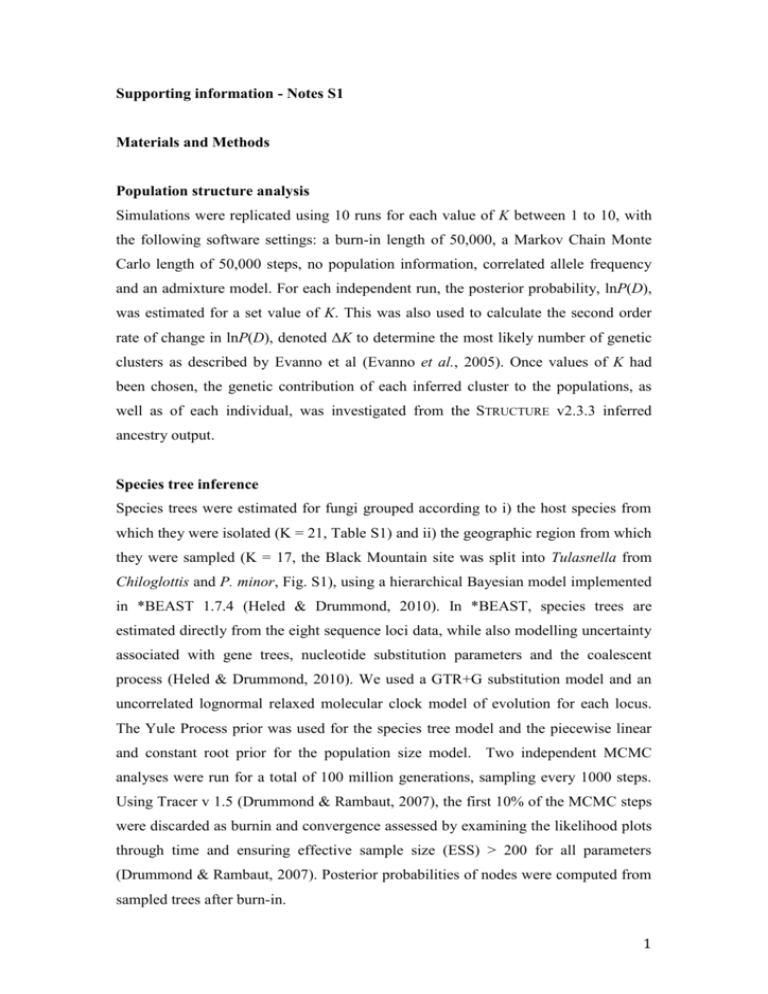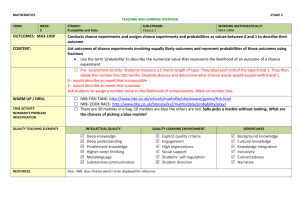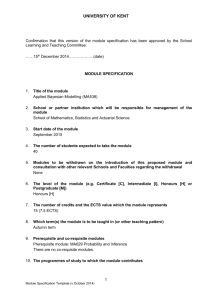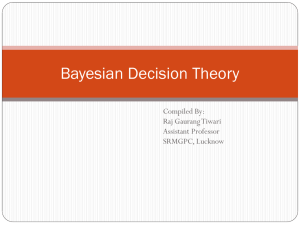Multiple sequence loci confirm strict host-specificity of
advertisement

Supporting information - Notes S1
Materials and Methods
Population structure analysis
Simulations were replicated using 10 runs for each value of K between 1 to 10, with
the following software settings: a burn-in length of 50,000, a Markov Chain Monte
Carlo length of 50,000 steps, no population information, correlated allele frequency
and an admixture model. For each independent run, the posterior probability, lnP(D),
was estimated for a set value of K. This was also used to calculate the second order
rate of change in lnP(D), denoted ΔK to determine the most likely number of genetic
clusters as described by Evanno et al (Evanno et al., 2005). Once values of K had
been chosen, the genetic contribution of each inferred cluster to the populations, as
well as of each individual, was investigated from the STRUCTURE v2.3.3 inferred
ancestry output.
Species tree inference
Species trees were estimated for fungi grouped according to i) the host species from
which they were isolated (K = 21, Table S1) and ii) the geographic region from which
they were sampled (K = 17, the Black Mountain site was split into Tulasnella from
Chiloglottis and P. minor, Fig. S1), using a hierarchical Bayesian model implemented
in *BEAST 1.7.4 (Heled & Drummond, 2010). In *BEAST, species trees are
estimated directly from the eight sequence loci data, while also modelling uncertainty
associated with gene trees, nucleotide substitution parameters and the coalescent
process (Heled & Drummond, 2010). We used a GTR+G substitution model and an
uncorrelated lognormal relaxed molecular clock model of evolution for each locus.
The Yule Process prior was used for the species tree model and the piecewise linear
and constant root prior for the population size model. Two independent MCMC
analyses were run for a total of 100 million generations, sampling every 1000 steps.
Using Tracer v 1.5 (Drummond & Rambaut, 2007), the first 10% of the MCMC steps
were discarded as burnin and convergence assessed by examining the likelihood plots
through time and ensuring effective sample size (ESS) > 200 for all parameters
(Drummond & Rambaut, 2007). Posterior probabilities of nodes were computed from
sampled trees after burn-in.
1
Bayesian species delimitation
Assuming no admixture following speciation, a multilocus, coalescent species
delimitation analysis was conducted using the program BPP 2.0 (Yang & Rannala,
2010) on the full eight loci dataset. This program uses a species phylogeny
represented by a user-specified guide tree, and accommodates lineage sorting
resulting from ancestral polymorphism. The guide trees estimated as above in
*BEAST included i) the 21 host-associated populations, ii) the 17 geographical
locations of samples, and iii) a guide tree based on a Chiloglottis phylogeny (Peakall
et
al.,
2010):
(((((Cdiphylla,Ctrilabra),Cseminuda),Creflexa),(Ctrapeziformis,Cformicifera)),(Caffje
anesii,Cvalida)). The third guide tree was included to further investigate Tulasnella
species boundaries associated with Chiloglottis. We used BPP algorithm 0 with fine
tune ε = 15. To confirm stability, different guide tree topologies were used in
additional runs. The prior distributions on the ancestral population size (θ) and root
age (τ0) were varied and incorporated into three models using a gamma prior (G),
similar to (Leaché & Fujita, 2010). The models included i) a large ancestral
population size with a deep divergence time [G(1,10) for θ and τ0], both with a prior
mean of 0.1, ii) a small ancestral population size with a shallow divergence time
[G(2,2000) for θ and τ0], both with a prior mean of 0.001, and iii) a large ancestral
population size with a shallow divergence time [G(1,10) for θ and G(2,2000) for τ0. A
Dirichlet prior was assigned to other divergence time parameters (Yang & Rannala,
2010). Each analysis (50 000 burnin, 500 000 MCMC generations) was run in
duplicate to confirm consistency between runs and ESS values > 1000 for all
parameters. Starting speciation models were confirmed to be different for replicate
runs.
Germination trials
Within eastern Australia, orchid seed was obtained from C. valida, C. aff. jeanesii, C.
trilabra (two locations), C. trapeziformis, C. seminuda and P. minor, and in Western
Australia from D. glyptodon, D. livida, D. micrantha, D. thynniphila and Paracaleana
nigrita. Seeds were subjected to germination trials with mycorrhizal isolates from
Chiloglottis (CLM309, CLM310, CLM152, CLM394, CLM068, CLM069, CLM516,
CLM159), Drakaea (CLM009, CLM251, CLM258, CLM252) and Paracaleana
2
(CLM222 and CLM228 from P. minor in eastern Australia, as well as CLM272 and
CLM274 from P. lyonsii and P. triens respectively in Western Australia). Seeds that
developed into protocorms with trichomes and a leaf primordium (Ramsay et al.,
1986), were considered to have germinated.
Results and Discussion
Population structure
Assignment tests for the two mitochondrial and six nuclear loci indicated that the
number of genetic clusters (K) among fungi from Chiloglottis was most likely K = 3
as indicated by the ΔK values (Supporting Information Fig. S10). However, at K = 3,
inferred ancestry of isolates assigned to a cluster was below 0.8 for eight of the nine
isolates in cluster 1, and for seven of the 13 isolates in cluster 2, indicating
considerable admixture. Similar to LnP(D), ΔK values also indicated K = 1 or 2 for
fungi from Drakaea + Paracaleana (Fig. S11). For Arthrochilus fungal populations, a
single genetic cluster was inferred as the most likely scenario by the lnP(D) whereas
ΔK indicated K = 5 clusters (Supporting Information Fig. S12).
References
Drummond AJ, Rambaut A. 2007. BEAST: Bayesian evolutionary analysis by
sampling trees. BMC Evolutionary Biology 7: 214.
Evanno G, Regnaut S, Goudet J. 2005. Detecting the number of clusters of
individuals using the software STRUCTURE: a simulation study. Molecular
Ecology 14: 2611-2620.
Heled J, Drummond AJ. 2010. Bayesian inference of species trees from
multilocus data. Molecular Biology and Evolution 27: 570-580.
Leaché AD, Fujita MK. 2010. Bayesian species delimitation in West African
forest geckos (Hemidactylus fasciatus). Proceedings of the Royal Society BBiological Sciences 277: 3071-3077.
Peakall R, Ebert D, Poldy J, Barrow RA, Francke W, Bower CC, Schiestl FP.
2010. Pollinator specificity, floral odour chemistry and the phylogeny of
3
Australian sexually deceptive Chiloglottis orchid: implications for
pollinator-driven speciation. New Phytologist 188: 437-450.
Ramsay RR, Sivasithamparam K, Dixon KW. 1986. Patterns of infection and
endophytes associated with Western Australian orchids. Lindleyana 1:
203-214.
Yang ZH, Rannala B. 2010. Bayesian species delimitation using multilocus
sequence data. Proceedings of the National Academy of Sciences of the
United States of America 107: 9264-9269.
4
Supporting information - Tables
Table S1 Fungal symbionts from Chiloglottis, Drakaea, Paracaleana and Arthrochilus used in phylogenetic analyses.
Isolate
number
CLM007
CLM009
CLM022
CLM027
CLM028
CLM031
CLM044
CLM047
CLM057
CLM059
CLM068
CLM069
CLM084
CLM085
CLM091
CLM092
CLM152
CLM157
CLM159
Host orchid
Arthrochilis oreophilus
Drakaea elastica
Arthrochilis oreophilus
Arthrochilis oreophilus
Arthrochilis oreophilus
Arthrochilis oreophilus
Chiloglottis seminuda
Chiloglottis seminuda
Chiloglottis seminuda
Chiloglottis seminuda
Chiloglottis diphylla
Chiloglottis diphylla
Arthrochilis oreophilus
Arthrochilis oreophilus
Arthrochilis oreophilus
Arthrochilis oreophilus
Chiloglottis reflexa
Chiloglottis trilabra
Chiloglottis trilabra
Location¶
Atherton Tablelands, Qld
Swan, WA
Atherton Tablelands, Qld
Atherton Tablelands, Qld
Atherton Tablelands, Qld
Atherton Tablelands, Qld
Fitzroy Falls, NSW
Kanangra Boyd NP, NSW
Fitzroy Falls, NSW
Kanangra Boyd NP, NSW
Bilpin, NSW
Bilpin, NSW
Atherton Tablelands, Qld
Atherton Tablelands, Qld
Atherton Tablelands, Qld
Atherton Tablelands, Qld
Mt Wilson, NSW
Kanangra Boyd NP, NSW
Kanangra Boyd NP, NSW
Origin
on
map†
9
3
9
9
9
9
13
10
13
10
11
11
9
9
9
9
12
10
10
GenBank accession numbers£
C3340
C4722
C10499
C12424
C14436
C4102
mtLSU
ITS
KF476130
KF476190
KF476236
KF476297
KF476359
KF476420
KF476480
KF476541
KF476131
KF476191
KF476237
KF476298
KF476360
KF476421
KF476481
KF476542
na
na
KF476238
KF476299
KF476361
KF476422
KF476482
KF476543
KF476132
na
KF476239
na
KF476362
na
KF476483
KF476544
KF476133
na
KF476240
KF476300
KF476363
na
*
KF476545
*
na
KF476241
KF476301
KF476364
KF476423
KF476484
KF476546
KF476134
KF476192
KF476242
KF476302
KF476365
KF476424
KF476485
KF476547
KF476135
KF476193
KF476243
KF476303
KF476366
KF476425
KF476486
KF476548
KF476136
KF476194
KF476244
KF476304
KF476367
KF476426
KF476487
KF476549
KF476137
KF476195
KF476245
KF476305
KF476368
KF476427
KF476488
KF476550
KF476138
KF476196
KF476246
KF476306
KF476369
KF476428
KF476489
KF476551
KF476139
KF476197
KF476247
KF476307
KF476370
KF476429
na
KF476552
KF476140
KF476198
na
KF476308
KF476371
KF476430
KF476490
KF476553
KF476141
na
na
KF476309
KF476372
KF476431
KF476491
KF476554
KF476142
na
KF476248
KF476310
KF476373
KF476432
KF476492
KF476555
KF476143
na
KF476249
KF476311
KF476374
KF476433
KF476493
KF476556
KF476144
KF476199
KF476250
KF476312
KF476375
KF476434
KF476494
KF476557
KF476145
KF476200
KF476251
KF476313
KF476376
KF476435
KF476495
na
KF476146
KF476201
KF476252
KF476314
KF476377
KF476436
KF476496
KF476558
5
CLM167
CLM222
CLM228
CLM234
CLM240
CLM246
CLM251
CLM252
CLM253
CLM254
CLM255
CLM256
CLM257
CLM258
CLM259
CLM260
CLM261
CLM265
CLM266
CLM267
CLM268
CLM272
CLM273
CLM274
CLM276
CLM277
CLM306
CLM308
CLM309
Chiloglottis trilabra
Paracaleana minor
Paracaleana minor
Paracaleana minor
Paracaleana minor
Paracaleana minor
Drakaea concolor
Drakaea concolor
Drakaea confluens
Drakaea elastica
Drakaea livida
Drakaea livida
Drakaea glyptodon
Drakaea glyptodon
Drakaea glyptodon
Drakaea elastica
Drakaea gracilis
Drakaea confluens
Drakaea confluens
Paracaleana hortiorum
Paracaleana terminalis
Paracaleana lyonsii
Drakaea livida
Paracaleana triens
Drakaea isolata
Drakaea gracilis
Chiloglottis formicifera
Chiloglottis formicifera
Chiloglottis aff. jeanesii
Kanangra Boyd NP, NSW
Black Mt, ACT
Black Mt, ACT
Black Mt, ACT
Black Mt, ACT
Black Mt, ACT
Kalbarri, WA
Kalbarri, WA
Darkan-Stirlings, WA
Swan, WA
Southern Forests, WA
Southern Forests, WA
Northern Sandplain, WA
Leeuwin-Naturaliste
Swan, WA
Swan, WA
Brookton, WA
Darkan-Stirlings, WA
Darkan-Stirlings, WA
Brookton, WA
Kalbarri, WA
Kalbarri, WA
Swan, WA
Brookton, WA
Southern wheatbelt, WA
Brookton, WA
Upper Kangaroo Valley, NSW
Upper Kangaroo Valley, NSW
Kanangra Boyd NP, NSW
10
16
16
16
16
16
1
1
5
3
8
8
2
7
3
3
4
5
5
4
1
1
3
4
6
4
14
14
10
KF476147
KF476202
KF476253
KF476315
KF476378
KF476437
KF476497
KF476559
KF476148
KF476203
KF476254
KF476316
KF476379
KF476438
KF476498
KF476560
KF476149
KF476204
KF476255
KF476317
KF476380
KF476439
KF476499
KF476561
KF476150
KF476205
KF476256
KF476318
KF476381
KF476440
KF476500
KF476562
KF476151
KF476206
KF476257
KF476319
KF476382
KF476441
KF476501
KF476563
KF476152
KF476207
KF476258
KF476320
KF476383
KF476442
KF476502
KF476564
KF476153
KF476208
KF476259
KF476321
KF476384
KF476443
KF476503
KF476565
KF476154
KF476209
KF476260
KF476322
KF476385
KF476444
KF476504
KF476566
KF476155
KF476210
KF476261
KF476323
KF476386
KF476445
KF476505
KF476567
KF476156
KF476211
KF476262
KF476324
KF476387
KF476446
KF476506
KF476568
KF476157
KF476212
KF476263
KF476325
KF476388
KF476447
KF476507
KF476569
KF476158
KF476213
KF476264
KF476326
KF476389
KF476448
KF476508
KF476570
KF476159
KF476214
KF476265
KF476327
KF476390
KF476449
KF476509
KF476571
KF476160
KF476215
KF476266
KF476328
KF476391
KF476450
KF476510
KF476572
KF476161
KF476216
KF476267
KF476329
KF476392
KF476451
KF476511
KF476573
KF476162
KF476217
KF476268
KF476330
KF476393
KF476452
KF476512
KF476574
KF476163
KF476218
KF476269
KF476331
KF476394
KF476453
KF476513
KF476575
KF476164
KF476219
KF476270
KF476332
KF476395
KF476454
KF476514
KF476576
KF476165
KF476220
KF476271
KF476333
KF476396
KF476455
KF476515
KF476577
KF476166
KF476221
KF476272
KF476334
KF476397
KF476456
KF476516
KF476578
KF476167
KF476222
KF476273
KF476335
KF476398
KF476457
KF476517
KF476579
KF476168
KF476223
KF476274
KF476336
KF476399
KF476458
KF476518
KF476580
KF476169
KF476224
KF476275
KF476337
KF476400
KF476459
KF476519
KF476581
KF476170
KF476225
KF476276
KF476338
KF476401
KF476460
KF476520
KF476582
KF476171
KF476226
KF476277
KF476339
KF476402
KF476461
KF476521
KF476583
KF476172
KF476227
KF476278
KF476340
KF476403
KF476462
KF476522
KF476584
KF476173
KF476228
KF476279
KF476341
KF476404
KF476463
KF476523
KF476585
KF476174
na
KF476280
KF476342
KF476405
KF476464
KF476524
KF476586
KF476175
KF476229
KF476281
KF476343
KF476406
KF476465
KF476525
KF476587
6
CLM310
CLM366
CLM373
CLM377
CLM394
CLM395
CLM417
CLM497
CLM499
CLM502
CLM505
CLM508
CLM516
CLM517
CLM518
Chiloglottis aff. jeanesii
Chiloglottis trapeziformis
Chiloglottis trapeziformis
Chiloglottis aff. jeanesii
Chiloglottis valida
Chiloglottis valida
Chiloglottis trapeziformis
Chiloglottis trapeziformis
Chiloglottis trapeziformis
Chiloglottis trapeziformis
Chiloglottis trapeziformis
Chiloglottis trapeziformis
Chiloglottis trapeziformis
Chiloglottis trapeziformis
Chiloglottis trapeziformis
Tallaganda State Forest, NSW
Black Mt, ACT
Black Mt, ACT
Kanangra Boyd NP, NSW
Kanangra Boyd NP, NSW
Kanangra Boyd NP, NSW
Black Mt, ACT
Black Mt, ANBG, ACT§
Black Mt, ANBG, ACT§
Black Mt, ANBG, ACT§
Black Mt, ANBG, ACT§
Black Mt, ANBG, ACT§
Black Mt, ACT
Black Mt, ACT
Black Mt, ACT
15
16
16
10
10
10
16
16
16
16
16
16
16
16
16
KF476176
*
KF476282
KF476344
KF476407
KF476466
KF476526
KF476588
KF476177
KF476230
KF476283
KF476345
KF476408
KF476467
KF476527
KF476589
KF476178
na
KF476284
KF476346
KF476409
KF476468
KF476528
KF476590
KF476179
KF476231
KF476285
KF476347
KF476410
KF476469
KF476529
KF476591
KF476180
KF476232
KF476286
KF476348
KF476411
KF476470
KF476530
KF476592
KF476181
KF476233
KF476287
KF476349
KF476412
KF476471
KF476531
KF476593
na
*
KF476288
KF476350
*
na
KF476532
KF476594
KF476182
*
KF476289
KF476351
KF476412
KF476472
KF476533
KF476595
KF476183
na
KF476290
KF476352
KF476413
KF476473
KF476534
KF476596
KF476184
na
KF476291
KF476353
KF476414
KF476474
KF476535
KF476597
KF476185
*
KF476292
KF476354
KF476415
KF476475
KF476536
KF476598
KF476186
*
KF476293
KF476355
KF476416
KF476476
KF476537
KF476599
KF476187
na
KF476294
KF476356
KF476417
KF476477
KF476538
KF476600
KF476188
KF476234
KF476295
KF476357
KF476418
KF476478
KF476539
KF476601
KF476189
KF476235
KF476296
KF476358
KF476419
KF476479
KF476540
KF476602
ACT = Australian Capital Territory, NSW = New South Wales, Qld = Queensland, WA = Western Australia. Regions for WA as per Phillips et
¶
al. (2011b).
§
ANBG = Australian National Botanic Gardens. This population is approximately 1 km away from the other populations on Black Mountain.
†
Refers to map in Fig. S1.
* Sequences shorter than 200bp could not be submitted to GenBank. These sequences are available from the authors on request.
£
Na = sequences unavailable, i.e. no usable sequence was obtained.
7
Table S2 Characteristics of phylogenetic markers for Tulasnella fungi from Chiloglottis, Drakaea, Paracaleana and Arthrochilus orchids.
Tulasnella from Chiloglottis
Tulasnella from Drakaea and
Tulasnella from Arthrochilus
Paracaleana
Locus
Aligned
No. of
No. of
Parsimony
No. of
No. of
Parsimony
No. of
No. of
Parsimony
name
length (bp)
isolates
variable
informative
isolates
variable
informative
isolates
variable
informative
sites (%)
sites (%)
sites (%)
sites (%)
sites (%)
sites (%)
1
C14436
550
27
12.7
5.1
26
3.6
2.5
9
19.3
4.7
2
C4102*
918
27
5.46.6
5.4
26
5.0
1.1
7
21.7
9.0
C3304
769
26
12.4
6.0
27
3.3
1.3
8
13.3
11.4
3
C4722*
701
23
6.0
4.7
26
5.3
3.7
2
7.8
-
4
C12424*
379
28
10.8
7.1
26
4.0
2.1
8
12.7
7.1
C10499
500
28
10.8
8.0
26
4.6
3.4
7
9.2
4.0
ITS
758
27
7.0
3.6
26
3.2
0.9
9
18.7
8.0
mtLSU
442
27
0.2
0.2
26
0.5
0.5
9
5.4
1.4
* Small intronic regions which were difficult to align were removed in the alignment for final analyses.
1
A 67 bp intron region deleted (bp183-250).
2
A 53 bp intron region deleted (bp 164-217).
3
A 73 bp intron region deleted (bp 13-86).
4
A 60 bp intron region deleted (bp 221-281).
8
Table S3 Bayesian posterior probabilities for the speciation models sampled by BPP
under different combinations of and 0 priors. The 95% credible model contains
only those nodes that are supported by all of the models in the 95% credible set of
models. We used algorithm 0 with fine tune ε = 15 for this analysis.
G(1, 10)
G(1, 10)
G(2, 2000)
0 G(1, 10)
0 G(2, 2000)
0 G(2, 2000)
11110001111100000000
0.00
0.00
-
11111001111000000000
-
0.01
-
11111001111100000000
0.66
0.42
0.37
11111001111110000000
0.05
0.05
0.10
11111001111110100000
0.00
0.00
0.03
11111001111111000000
0.00
0.00
0.07
11111001111111100000
0.00
0.00
0.01
11111011111000000000
-
0.00
-
11111011111100000000
0.01
0.02
0.01
11111011111110000000
0.00
0.00
0.00
11111011111110100000
-
0.00
0.00
11111011111111000000
0.00
-
0.00
11111011111111100000
-
-
0.00
11111101111100000000
0.26
0.40
0.17
11111101111110000000
0.02
0.06
0.07
11111101111110100000
0.00
0.00
0.01
11111101111111000000
0.00
0.00
0.03
11111101111111100000
-
0.00
0.06
11111111111000000000
-
0.00
-
11111111111100000000
0.00
0.01
0.00
11111111111110000000
0.00
0.00
0.00
11111111111110100000
-
0.00
0.00
Speciation model
Orchid-host-associated
guide tree
9
11111111111111000000
-
0.00
0.00
11111111111111100000
-
0.00
0.00
11110001111100000000
-
0.00
-
95% credible model
11111001111100000000
11111001111100000000
11111001111100000000
1110101011000000
0.01
0.00
-
1110101011100000
0.00
-
-
1110101011110000
0.00
0.00
-
1110101011111000
-
0.00
-
1110101111000000
0.01
0.00
-
1110101111100000
0.00
0.00
0.00
1110101111110000
0.00
0.00
-
1110101111111000
0.00
0.00
-
1110101111111010
-
0.00
-
1110101111111010
-
0.00
-
1110101111111100
-
0.00
-
1110101111111110
-
0.00
-
1110111011000000
0.01
0.00
0.00
1110111011100000
0.00
0.01
-
1110111011110000
0.00
0.00
-
1110111011111000
-
0.00
-
1110111111000000
0.01
0.01
0.00
1110111111100000
0.00
0.00
0.00
1110111111110000
0.00
0.00
0.00
1110111111111000
0.00
0.00
-
1110111111111100
-
0.00
-
1110111111111110
-
0.00
-
1111101011000000
0.13
0.05
0.00
1111101011100000
0.06
0.07
0.02
1111101011110000
0.01
0.01
0.00
1111101011111000
0.00
0.00
0.00
1111101011111010
0.00
0.00
-
Geography guide tree
10
1111101011111100
0.00
0.00
0.00
1111101011111110
0.00
-
-
1111101111000000
0.12
0.06
0.00
1111101111100000
0.07
0.08
0.02
1111101111110000
0.01
0.01
0.00
1111101111111000
0.00
0.00
0.00
1111101111111010
0.00
0.00
0.00
1111101111111100
0.00
0.00
-
1111101111111110
0.00
0.00
-
1111111011000000
0.19
0.11
0.06
1111111011100000
0.09
0.15
0.27
1111111011110000
0.01
0.03
0.04
1111111011111000
0.00
0.00
0.00
1111111011111010
0.00
0.00
-
1111111011111100
0.00
0.00
0.00
1111111011111110
-
0.00
-
1111111111000000
0.17
0.11
0.05
1111111111100000
0.09
0.20
0.44
1111111111110000
0.01
0.04
0.06
1111111111111000
0.00
0.01
0.00
1111111111111010
0.00
0.00
0.00
1111111111111100
0.00
0.00
0.00
1111111111111110
-
0.00
0.00
95% credible model
1111111011000000
1111111111100000
1111111111100000
1111100
-
0.00
-
1111101
-
0.00
-
1111110
0. 90
0.89
0.95
1111111
0.10
0.11
0.05
1111110
1111110
1111110
Chiloglottis host guide
tree
95% credible model
11
Table S4 Results of germination trials with Tulasnella isolates and orchid seed combinations used.
Isolate
Host
Orchid seed
C. valida
number
C. aff.
C. trilabra
C. trilabra
C.
jeanesii
(Black Mtn)
(Kanangra
trapeziformis
Boyd NP)
(Black Mtn)
C. seminuda
D.
D. livida
D.
D.
micrantha
thinniphila
-
-
-
-
glyptodon
P. nigrita
CLM309
C. aff. jeanesii
G
G
-
-
G
G
-
CLM310
C. aff. jeanesii
G
G
-
-
-
-
-
CLM152
C. reflexa
G
G
G
-
G
G
-
CLM394
C. valida
G
G
-
-
-
-
-
CLM069
C. diphylla
-
-
-
-
-
G
CLM332
C. diphylla
G
G
-
G
-
G
CLM516
C. trapeziformis
-
-
G
-
-
G
CLM159
C. trilabra
-
-
-
G
-
G
CLM222
P. minor
-
-
-
-
-
G
-
G
-
-
CLM228
P. minor
-
-
-
-
-
G
G
G
G
G
12
CLM274
P. triens
-
-
-
-
-
G
G
G
-
-
CLM272
P. lyonsii
-
-
-
-
-
G
G
-
-
G
CLM251
D. concolor
-
-
-
-
-
G
G
-
G
-
CLM258
D. glyptodon
-
-
-
-
-
-
-
G
-
-
CLM252
D. concolor
-
-
-
-
-
G
G
-
G
CLM009
D. elastica
-
-
G
G
G
G
G
G
= germinated, - = tested but did not germinate.
13
Supporting information - Figures
Fig. S1 Distribution of Tulasnella samples obtained from orchids in Australia.
Distribution locations follow those given in Table S1. All Chiloglottis species and
Paracaleana minor were collected from eastern Australia; Drakaea, Paracaleana
hortiorum, Paracaleana triens, Paracaleana lyonsii and Paracaleana terminalis from
Western Australia; and A. oreophilus from north-eastern Australia.
14
15
Fig. S2 Midpoint rooted Maximum Likelihood tree for Tulasnella obtained for the mtLSU. The tree with the highest log likelihood is shown.
The numbers above the branches are maximum likelihood bootstrap values/Bayesian posterior probabilities. Bootstrap values of ≥70% and
Bayesian posterior probabilities of ≥0.80 are shown. The branch length is proportional to the inferred divergence level.
16
17
Fig. S3 Midpoint rooted Maximum Likelihood tree for Tulasnella obtained for locus C4102. The tree with the highest log likelihood is shown.
The numbers above the branches are maximum likelihood bootstrap values/Bayesian posterior probabilities. Bootstrap values of ≥70% and
Bayesian posterior probabilities of ≥0.80 are shown. The branch length is proportional to the inferred divergence level.
18
19
Fig. S4 Midpoint rooted Maximum Likelihood tree for Tulasnella obtained for locus C12424. The tree with the highest log likelihood is shown.
The numbers above the branches are maximum likelihood bootstrap values/Bayesian posterior probabilities. Bootstrap values of ≥70% and
Bayesian posterior probabilities of ≥0.80 are shown. The branch length is proportional to the inferred divergence level.
20
21
Fig. S5 Midpoint rooted Maximum Likelihood tree for Tulasnella obtained for locus C14436. The tree with the highest log likelihood is shown.
The numbers above the branches are maximum likelihood bootstrap values/Bayesian posterior probabilities. Bootstrap values of ≥70% and
Bayesian posterior probabilities of ≥0.80 are shown. The branch length is proportional to the inferred divergence level.
22
23
Fig. S6 Midpoint rooted Maximum Likelihood tree for Tulasnella obtained for locus C3304. The tree with the highest log likelihood is shown.
The numbers above the branches are maximum likelihood bootstrap values/Bayesian posterior probabilities. Bootstrap values of ≥70% and
Bayesian posterior probabilities of ≥0.80 are shown. The branch length is proportional to the inferred divergence level.
24
25
Fig. S7 Midpoint rooted Maximum Likelihood tree for Tulasnella obtained for locus C4722. The tree with the highest log likelihood is shown.
The numbers above the branches are maximum likelihood bootstrap values/Bayesian posterior probabilities. Bootstrap values of ≥70% and
Bayesian posterior probabilities of ≥0.80 are shown. The branch length is proportional to the inferred divergence level.
26
27
Fig. S8 Midpoint rooted Maximum Likelihood tree for Tulasnella obtained for locus C10499. The tree with the highest log likelihood is shown.
The numbers above the branches are maximum likelihood bootstrap values/Bayesian posterior probabilities. Bootstrap values of ≥70% and
Bayesian posterior probabilities of ≥0.80 are shown. The branch length is proportional to the inferred divergence level.
28
(a)
(b)
29
(c)
Fig. S9 The coalescent-based species trees and Bayesian species delimitation results
for Tulasnella Bayesian species trees inferred with *BEAST assuming (a) an orchid
host-associated guide tree, (b) a guide tree based on geography of samples and (c) a
Chiloglottis species phylogeny guide tree for Tulasnella isolates from Chiloglottis.
The species probabilities are provided above the line for each node under each
combination of priors for and 0: top, prior means = 0.001; middle, prior mean =
0.1, prior mean 0 = 0.001; bottom, prior means = 0.1. Posterior probabilities values
below the line indicate support from *BEAST. Thick lines indicate support with both
BPP and *BEAST.
30
C.#valida#
C.#trilabra#
C.#trapeziformis#
C.#seminuda#
C.#reflexa#
C.#formicifera#
C.#diphylla#
(b)
C.#aff.#jeanessii#
(a)
Tulasnella$from:$
Fig. S10 Bayesian model-based clustering likelihoods and ΔK model selection for 28 fungal isolates from Chiloglottis. (a) The log probability
of the data {ln[P(D|K
ΔK (Evanno et al., 2005) as a function of K (number of clusters) from the STRUCTURE simulations.
Bars represent the variation of 10 replicate runs at each K value. (b) Ancestry estimates based on K = 3.
31
P.#terminalis#
P.#triens#
P.#minor##
P.#hor=orum#
P.#lyonsii#
D.#livida#
D.#isolata#
D.#gracilis#
D.#glyptodon#
D.#elas=ca#
D.#confluens#
(b)
D.#concolor#
(a)
Tulasnella$from:$
Fig. S11 Bayesian model-based clustering likelihoods and ΔK model selection for 26 fungal isolates from Drakaea + Paracaleana. (a) The log
probability of the data {ln[P(D|K
ΔK (Evanno et al., 2005) as a function of K (number of clusters) from the STRUCTURE
simulations. Bars represent the variation of 10 replicate runs at each K value. (b) Ancestry estimates based on K = 2.
32
(a)
(b)
Fig. S12 Bayesian model-based clustering likelihoods and ΔK model selection for nine fungal isolates from Arthrochilus. (a) The log
probability of the data {ln[P(D|K
ΔK (Evanno et al., 2005) as a function of K (number of clusters) from the
STRUCTURE simulations. Bars represent the variation of 10 replicate runs at each K value. (b) Ancestry estimates based on K = 3.
33








